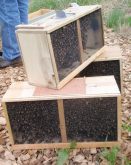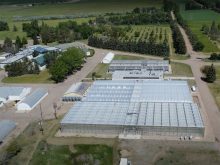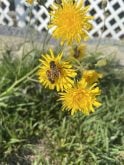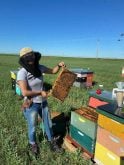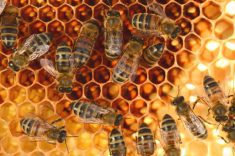Glacier FarmMedia – Beekeeping groups on the Prairies say it’s a good thing Western Canada’s sugar shortage didn’t happen a few months ago.
The bees are now tucked away for the winter, but August and September are prime feeding seasons when beekeepers condition their colonies for winter and natural nectar sources are drying up.
“We’ve always taken for granted that the sugar’s always been there,” said Ian Steppler, chair of the Manitoba Beekeepers’ Association. “The entire time I’ve been beekeeping, I’ve never thought twice about sugar availability, other than just the price going up a little bit because of supply and demand.”
Read Also

The long march to autonomy
The big players in the machinery market keep adding pieces towards autonomous vehicles for farming, but how far away is a final product?
“There’s not an issue right now,” said Connie Phillips, executive director of the Alberta Beekeepers Commission. “I think the concern is, if the shortage persists, that it will be a big issue in the spring when we start feeding again.”
Anyone hoping to start December with a batch of holiday cookies likely had to reach for a different sweetener.
Sugar was at a premium in grocery stores across Western Canada in late November, leading retailers to place per-customer limits on remaining stock.
A big part of the problem was an ongoing strike at a sugar refinery in Vancouver owned by Rogers Sugar, the holding company for Lantic Inc. The facility is the second largest of the three refineries operated by the company, which is Canada’s biggest sugar supplier, and the only major cane sugar refinery in Western Canada.
Workers at the Vancouver plant have been on strike since late September.
Western Canada’s honey sector largely depends on the same company for feed sucrose, although those products largely come from the company’s beet sugar plant in Taber, Alta.
Sugar feeding
Spring and fall are the main feeding seasons, when nectar sources are thin on the ground. There is some nectar available in the spring, Steppler said, and bees would “probably be able to get by” if producers couldn’t feed.
Then the season enters honey flow. During that time, beekeepers harvest what, naturally, would be winter feed in the hive. Not only does this add volume to their harvest, Steppler noted, but canola honey — the bread and butter of beekeeping operations in Western Canada — makes poor winter feed for the bees.
Instead, the honey goes into beekeepers’ tanks and the brood is fed high-quality sugar to build up winter stores.
Few options
Both Manitoba and Alberta groups say the strike and subsequent supply chain shortages have highlighted a vulnerability in their industry.
“We need more than just one supplier of sugar. We need a backup,” Steppler said, adding that he plans to raise the issue with the national producer organization.
He questioned why relationships are not in place to potentially bring sugar from North Dakota, where there is an established sugar beet industry. In Manitoba, that would be closer than bringing it from Alberta.
But Phillips notes Alberta is the heart of Canada’s sugar beet industry, and that hasn’t helped their beekeepers develop alternatives.
“Manitoba’s right,” she said. “We need to be a little bit more certain about supply.”
Sugar beets had a good year in Alberta, she said, but that’s naturally limited by processing capacity.
Phillips also noted the sugar beet industry in Alberta has been pushing for a national sugar policy for years.
Alberta Sugar Beet Growers indicate that only eight to 10 per cent of Canadian sugar comes from their farms. Most is drawn from imported cane sugar. The group has argued for a policy that would “prioritize the production of beet sugar,” according to its website.
That would be good news for the honey sector, which prefers beet sugar to cane sugar.
Supply from the U.S. might have its own issues.
A few years ago, Alberta did run short of apiary sugar supplies, Phillips said. Several producers tried to source from the U.S., but ran into issues when bringing supplies across the border.
“The distributor agreed to sell the sugar, but then the sugar supplier to the distributor refused,” she said.
Guy Chartier, CEO of Bee Maid honey, agreed that supply might be a concern if the shortage happened in spring and fall, but the strike is at a cane sugar plant in Vancouver where most beekeepers don’t source product.
Problems would arise if Canada’s sugar supply was so disrupted that supplies from Taber were used up.
“Who knows,” he said. “If this strike keeps going for more months… until spring, could that become an issue? I’m not sure.”
Corn syrup
Without sugar, Manitoba beekeepers might turn to cheaper high-fructose corn syrup, but that comes with animal health issues.
Corn syrup degrades quicker than sucrose, Steppler noted. That’s a problem in a Prairie winter, when bees might be confined for five months or more. The less-pure sugar source also leads to more waste, which is hard on the bees’ digestive system.
“Beekeepers do find issues with dysentery when they feed corn syrup,” he said.
That’s sometimes less of an issue in spring, when the bees can fly and defecate outside, he noted. But in fall, lack of sucrose could be disastrous.
On the production side, Phillips said corn syrup can add characteristics that make honey test as adulterated.
Alberta doesn’t use corn syrup but that is more common in the east, she added.
Looking ahead
As of print deadline, the future of the sugar market was unclear. Even if supply does increase, getting sugar back on the grocery shelves is different from obtaining supply for bees.
However, there may be a silver lining. There are lots of consumers looking to bake for the holidays and without sugar, they could boost honey sales.
– Alexis Stockford is associate editor for the Manitoba Co-operator.




